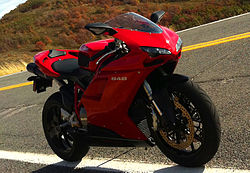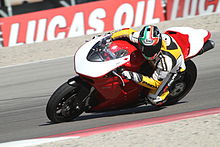- Ducati 848
-
Ducati 848 
Manufacturer Ducati Production since 2008 Predecessor Ducati 749 Class sport bike Engine 849 cc (51.8 cu in), 4 valves per cylinder desmodromic liquid cooled L-twin
Compression ratio: 12:1[1]
Bore x stroke: 94 × 61.2 mm (3.7 × 2.41 in)Top speed 159 mph (256 km/h)[2] Power 115.6 bhp (86.2 kW) @ 10,400 rpm[3]
117 bhp (87 kW) @ 10,010 rpm[2]
134 hp (100 kW) @ 10,000 rpm[1]Torque 62 lb·ft (84.1 N·m)[3]
63.1 lb·ft (85.6 N·m) @ 8325 rpm[2]
70.8 lb·ft (96.0 N·m) @ 8,250 rpm[1]Transmission 6 speed, wet clutch[1] Suspension Front: Showa fully adjustable upside-down forks, 127 mm (5.0 in) travel
Rear: Showa fully adjustable monoshock, 120 mm (4.7 in)travel[1]Brakes Front: Two 320 mm semi-floating discs, radial Brembo 4-piston calipers
Rear: 245 mm disc, 2-piston caliper[1]Tires Front: 120/70 ZR17
Rear: 180/55 ZR17 [1]Rake, Trail 24.5°,[1] 97 mm (3.8 in)[3] Wheelbase 1,430 mm (56 in)[1] Dimensions L 2,100 mm (83 in)[4]
H 1,100 mm (43 in)[4]Seat height 830 mm (33 in)[1] Weight 168 kg (370 lb)[1] (dry) Fuel capacity 15.5 l (3.4 imp gal; 4.1 US gal) incl 4.1 l (0.90 imp gal; 1.1 US gal) reserve[1] Fuel consumption 44 mpg-US (5.3 L/100 km; 53 mpg-imp)[2] Related Ducati 1198 The Ducati 848 is a 849 cc (51.8 cu in) L-twin sport bike manufactured by Ducati. It was announced on November 6, 2007 for the 2008 model year and replaces the 749, although the 848 model name was already listed on the compatible parts table for the 1098 fuel tank, giving away the secret a few months early. The 848 makes a tested 115.6 hp (86 kW) at 10,000 rpm and 62 lb·ft (84.1 N·m) at 8,250 rpm.[3] With a manufacturer claimed dry weight of 168 kg (370 lb), the 848 undercuts its larger displacement sibling, the 1198, by 5 kg (11 lb).
In August 2010, Ducati announced the 848 Evo, as the evolution of the model. The bike featured small revisions such as a black swingarm, Mono-block Brembo brake calipers, steering damper mount as well as some very minor engine revisions.[5]
Contents
Changes from predecessor
Trellis frame
Developed in cooperation with Ducati Corse, the 848 Trellis frame uses a simplified tube layout from the Ducati 749 featuring main section tubes that are enlarged in diameter from 28 mm to 34 mm, while being reduced in thickness from 2 mm to 1.5 mm. The result is a 14% increase in rigidity and a weight saving of 1.5 kg (3.3 lbs) helping the 848 weigh in 44 lbs less overall than the 749. [6]
Engine revision
 Race-Prepped Ducati 848 at Miller Motorsports Park
Race-Prepped Ducati 848 at Miller Motorsports Park
While most of the chassis components are identical to the 1098/1198, the motor was an all new design in 2008. Producing roughly 116 hp at the rear wheel it out performs the revered Ducati 916 that had a hard time producing more than 100hp and even the upgraded Ducati 998 that produced 110 hp at the rear wheel. The "Testastretta Evoluzione" uses a 94 x 61.2mm bore and stroke for 849cc of displacement despite the bikes moniker of 848. The motor casings were constructed using a new vacuum die-casting method called Vacural that helps the engine weigh seven lbs less than the Ducati 749. The intake valves were increased 2.5mm from the Ducati 749 numbers to 39.5mm. The exhaust valves were enlarged 1.5mm to 32mm. The valve angles are identical to the Ducati 1098.[7] The bike uses a pair of elliptical shaped 56mm throttle bodies fashioned after MotoGP designs. [8]
The 2011 Ducati 848 Evo featured minor changes to the engine, including new Marelli throttle bodies, revised cylinder heads with straighter intake ports and reshaped combustion chambers. Ducati claimed these changes would result in a 6-hp increase, bringing output to 140 measured at the crank, however Cycle World Magazines first dyno test of the engine showed a mere 1.6 hp increase over the previous motor. [5]
Wet clutch
Although the 1198 and 848 share many similar components, as per the 916/748 and 999/749 models, the 848 uses a wet clutch rather than the traditional dry clutch of previous superbikes from Ducati. The manufacturer claims it reduces weight, improves both service life and "feel" of the clutch and reduces noise.[9] Ducati has in the past held to only dry clutches in accordance with marketing their bikes as obeying the design imperatives of racing above all, unlike, as Ducati would have it, ordinary street bikes.[10] While a dry clutch "rattles like a bucket of rocks,"[11] Ducati and its adherents felt the clutch's "typical noise is music to bikers' ears."[10] The 848's wet clutch is a stark departure from this, because, "Ducati made it very clear that there is a new philosophy within the factory to develop each bike with specifications and capabilities that are aligned with the bike's target audience and intended environment."[12]
Comparison with larger Ducati superbikes
The 848 shares more physical and technical design elements with the stronger 1098/1198 than its predecessor, the 749, did with the 999. In many cases the 1098/1198 and the 848 are identical right down to the part numbers.
The two bikes use the same bodywork, including the fuel tank. With the exception of the steering damper mount, the frame between the bikes is the same, which results in identical wheelbase and rake and trail numbers. The second generation 848 Evo features the same monoblock brakes and the same frame with the steering damper mount as the 1098/1198. The rear suspension, including the suspension linkage is the same, using identical Showa shocks. Many components of the exhaust system are shared, including the exhaust canisters that house the muffler and catalytic converter.
Despite the difference in engine displacement, the two bikes share valve angles and magnesium valve covers. The oil cooler and radiator are also very similar. The transmissions are different with the ratios on the 848 being closer together.
One of the more notable difference between the two bikes (aside from the engine) is the brakes. On the 848, the four-caliper Brembo front brakes are cast rather than machined monoblocs. The 848 requires greater braking effort than the 1098/1198, in spite of its lighter weight.[13]
Notes
- ^ a b c d e f g h i j k l Ducati 848 Tech Spec, Ducati Motor Holding, 2009, http://www.ducati.com/en/bikes/my2009/ModelPage.jhtml?family=Superbike&model=SBK848-09
- ^ a b c d "Cycle World - 2x2: 2009 Ducati 848 vs. 2009 Triumph Daytona 675:", Cycle World (Hachette Filipacchi Media, U.S.), July 2009, http://www.cycleworld.com/motorcycle_roadtest/comparison_tests_articles/archive/2x2_2009_ducati_848_vs._2009_triumph_daytona_675/2009_ducati_848_vs._2009_triumph_daytona_675_comparison_test_review_page_2, retrieved 2011-08-17
- ^ a b c d Duke (2007)
- ^ a b "Ducati 848", Web Bike World (webWorld International), 2009, http://www.webbikeworld.com/ducati-motorcycles/ducati-848/
- ^ a b 2011 Ducati 848 EVO - World Exclusive First Test, August 2010 http://www.cycleworld.com/motorcycle_roadtest/single_bike_tests_articles/10q3/2011_ducati_848_evo_-_world_exclusive_first_test
- ^ Ducati Announces the 848 Superbike! http://www.webbikeworld.com/ducati-motorcycles/ducati-848/
- ^ 2008 Ducati 848 and 1098R First Look, November 5, 2007 http://www.motorcycle-usa.com/353/1238/Motorcycle-Article/2008-Ducati-848-and-1098R-First-Look.aspx
- ^ 2008 Ducati Road Test, A class of its own, December 28, 2007 http://www.motorcycle.com/manufacturer/ducati/2008-ducati-848-road-test-71220.html
- ^ Ducati 848 MY08 Specifications, Ducati.com, http://www.ducati.com/en/bikes/my2008/ModelPage.jhtml?family=Superbike&model=SBK848-08
- ^ a b Ducati TechCafe FAQ
- ^ Bond (2006)
- ^ Norris (2008)
- ^ Cernicky (2007)
References
- Bond, Steve (9 December 2006), Gorgeous Monster totally impractical, Toronto Star, http://www.thestar.com/printArticle/131390
- Cernicky, Mark (December 2007), "WebRide: 2008 Ducati 848", Cycle World (Hachette Filipacchi Media, U.S.), http://www.cycleworld.com/article.asp?section_id=3&article_id=568
- Ducati TechCafe FAQ, "7) Why do Ducatis have dry clutches?", Ducati.com, Ducati Motor Holding, http://www.ducati.com/bikes/techcafe.jhtml?part=faq&value=faq#question7
- Duke, Kevin (28 December 2007), "2008 Ducati 848 Road Test", Motorcycle.com, http://www.motorcycle.com/manufacturer/ducati/2008-ducati-848-road-test-71220.html, retrieved 2008-03-20
- Hutchison, Ken (17 December 2007), "2008 Ducati 848 First Ride", MotocycleUSA.com, http://www.motorcycle-usa.com/65/240/Motorcycle-Article/2008-Ducati-848-First-Ride.aspx
- Norris, Mark (4 January 2008), "Soup Tested: 2008 Ducati 848; Addition By Subtraction", SuperbikePlanet.com (Hardscrabble Media), http://www.superbikeplanet.com/2008/Jan/0801-848test.htm
- Norris, Mark (10 January 2008), "Ducati 848 vs. 1098S: A Snap Shot Comparison", SuperbikePlanet.com (Hardscrabble Media), http://www.superbikeplanet.com/2008/Jan/080110vs.htm
- Video: First ride of the new Ducati 848, Motorcycle News, 3 December 2007
- Video: Ducati 1098 vs 848, Motorcycle News, 19 December 2007
External links
- Ducati 848, Ducati
- Ducati at the Open Directory Project
Ducati Current motorcycles: 848 · 1198 · 1199 · Diavel · Hypermotard · Monster (696 · 796 · 1100) · Multistrada 1200 · StreetfighterPrevious motorcycles: 60, 60S, 65S · 65T, 65TL, 65TS · 98, 98N, 98T, 98TL, 98S, 98SS · 98TS and 85, 98, 125 Bronco · 125 Aurea · 125 T, TV · Apollo · Mach 1 · 750 GT · 900GTS · Pantah · Paso · 851 · 888 · SuperSport · 916 · 748 · 996 · 998 · 800SS · 749 · 999 · 1098 · Desmosedici RR · ST series · SportClassicDucati mopeds: Other products: Sogno (camera)Designers Ducati Corse racing Categories:- Ducati motorcycles
- Vehicles introduced in 2008
- Sport bikes
Wikimedia Foundation. 2010.

